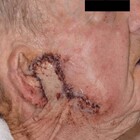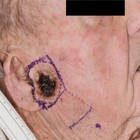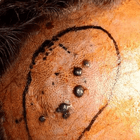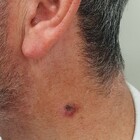Head & Neck Skin Cancer
Head & Neck Melanoma
While less common than BCCs and SCCs, melanoma is the most dangerous form of skin cancer due to its ability to metastasise (spread) to other parts of the body (lymph nodes or other distant organs), if not detected and treated early. Arising from melanocytes that produce skin pigment, common sites for head and neck melanoma include the face, scalp, ears, neck, and the mucous membranes inside the mouth and nasal passages. Melanoma may itch, bleed, or become painful as it grows. It can also resemble a non-healing sore or ulcer.
Existing moles or new ones may appear as altered pigmented lesions on the skin, often exhibiting irregular borders, asymmetry, varied colouration, and a diameter larger than a pencil eraser. Hence, this cancer warrants vigilant self-examination for changes (size, ulceration, nodularity, colour etc.) in moles or freckles especially on the head and neck. Any new mole or alteration should prompt evaluation by a healthcare professional to assess for potential malignancy particularly, as enlarged lymph nodes in the neck can sometimes indicate initial signs of melanoma spread.
Incidence rates are among the world's highest In New Zealand and Australia. Despite its propensity to spread, approximately 75% of melanomas are detected early before metastasis, allowing for effective treatment and cure. Risk factors also include intense sun exposure, fair skin and sun burns. Additionally, certain genetic mutations, such as those in the CDKN2A gene, can predispose individuals to melanoma.
Malignant melanoma presents in various forms, each with distinct characteristics and prognostic implications. These forms include lentigo malignant melanoma featuring a prolonged radial growth phase and precursor lesion known as lentigo maligna; acral lentiginous melanoma prevalent in darker-skinned individuals and often found on palms, soles, and mucosal surfaces with aggressive biological behavior; superficial spreading melanoma, starting with a radial growth phase; nodular melanoma known for its poor prognosis due to immediate invasion; and mucosal melanoma, characterised by late presentation and high invasive potential, resulting in a poor prognosis.
Mucosal head and neck melanoma is a rare variant of melanoma primarily found in the nasal cavity, sinuses, or occasionally in the oral cavity. Surgical resection margins are constrained by nearby structures and the potential impact on both function and appearance. In nasal cavity lesions, regional lymph node involvement is uncommon, whereas in oral cavity lesions, occult metastasis rates are approximately 30%, highlighting the importance of Elective Lymph Node Dissection (ELND) for thorough management.




